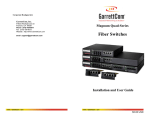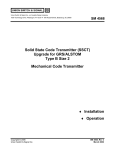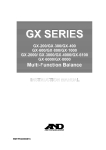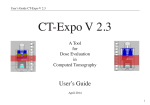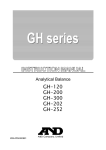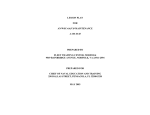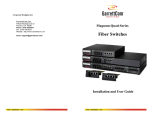Download Chicago Transit Authority
Transcript
Union Switch & Signal Inc., an Ansaldo Signal company 1000 Technology Drive, Pittsburgh, PA 15219 ● 645 Russell Street, Batesburg, SC 29006 SM 8524A Shelf-Mounted Style Solid State Code Transmitter (N407016XX) (Replacement for DM Style Electromechanical and DM Style Solid State Code Transmitter) US&S Part No. N40701601 N40701602 N40701603 N40701604 N40701605 N40701606 N40701607 N40701608 N40701609 ♦ Installation ♦ Operation Copyright © 2005 Union Switch & Signal Inc. SM 8524A, August 2005 Original Notices Proprietary Notice This document and its contents are the property of Union Switch & Signal Inc. (hereinafter US&S). This document has been furnished to you on the following conditions: no right or license under any patents or any other proprietary right in respect of this document or its content is given or waived in supplying this document. This document or its content are not to be used or treated in any manner inconsistent with the rights of US&S, or to its detriment, and are not to be copied, reproduced, disclosed to others, or disposed of except with the prior written consent of US&S. Important Notice US&S constantly strives to improve our products and keep our customers apprised of changes in technology. Following the recommendations contained in the attached service manual will provide our customers with optimum operational reliability. The data contained herein purports solely to describe the product, and does not create any warranties. Within the scope of the attached manual, it is impossible to take into account every eventuality that may arise with technical equipment in service. Please consult your local US&S Account Executive in the event of any irregularities with our product. We expressly disclaim liability resulting from any improper handling or use of our equipment, even if these instructions contain no specific indication in this respect. We strongly recommend that only approved US&S spare parts be used as replacements. SM 8524A Original, August 2005 i Revision History REVISION HISTORY Rev. Original ii Date August 2005 Nature of Revision Original SM 8524A Original, August 2005 Tale of Contents Table of Contents 1 2 3 4 5 6 7 Introduction..................................................................................................................1-1 1.1 Introduction and Applications ............................................................................... 1-1 1.2 Purpose of Manual ............................................................................................... 1-1 1.2.1 Abbreviations and Acronyms ..................................................................... 1-2 1.3 Safety ................................................................................................................... 1-3 1.4 Part Numbers ....................................................................................................... 1-3 Specifications ..............................................................................................................2-1 2.1 Identification ......................................................................................................... 2-1 Functional Description ................................................................................................3-1 3.1 Functional Overview ............................................................................................. 3-1 3.2 Detailed Functional Description ............................................................................ 3-3 Installation....................................................................................................................4-1 4.1 Installation Overview ............................................................................................ 4-1 4.2 Installation Procedure........................................................................................... 4-2 4.3 Operational Verification Test ................................................................................ 4-3 Operation/Maintenance ...............................................................................................5-1 5.1 Operation.............................................................................................................. 5-1 5.2 Field Maintenance ................................................................................................ 5-1 5.2.1 Schedule.................................................................................................... 5-1 5.2.2 Preventive Maintenance ............................................................................ 5-1 5.2.3 Calibration.................................................................................................. 5-1 5.2.4 Adjustment................................................................................................. 5-1 5.3 Shop Maintenance................................................................................................ 5-1 5.3.1 Equipment Required .................................................................................. 5-1 5.3.2 Test Procedure .......................................................................................... 5-2 Troubleshooting...........................................................................................................6-1 6.1 Repairing/Replacing Components ........................................................................ 6-1 Technical Support........................................................................................................7-1 SM 8524A Original, August 2005 iii Table of Contents List of Figures Figure 1-1 Figure 2-1 Figure 3-1 Figure 3-2 Figure 4-1 Figure 4-2 Figure 5-1 - Shelf-Mounted SSCT ...................................................................................... 1-1 Shelf-Mounted SSCT Typical Identification Label ........................................... 2-2 DM SSCT Functional Block Diagram .............................................................. 3-1 Relay Terminals and Internal Wiring ............................................................... 3-2 Overall Dimensions and Mounting Holes for the Shelf Mounted SSCT........... 4-1 Installation Check List ..................................................................................... 4-3 DM SSCT Test Circuit..................................................................................... 5-3 List of Tables Table 1-1 Table 1-2 Table 2-1 Table 3-1 Table 6-1 iv - Abbreviations and Acronyms............................................................................ 1-2 Part Number Cross Reference ......................................................................... 1-3 General Specifications ..................................................................................... 2-1 Timing Parameters ........................................................................................... 3-2 SSCT Troubleshooting ..................................................................................... 6-1 SM 8524A Original, August 2005 Introduction 1 Introduction 1.1 Introduction and Applications The shelf mounted solid state code transmitter (SSCT) (Figure 1-1) is designed to be a functional electronic replacement for the Union Switch and Signal (US&S) DM style electromechanical and DM style solid state code transmitters. The original electromechanical DM style code transmitter is a relay that needs to be periodically inspected and serviced. The shelf-mounted SSCT, like the DM style SSCT, contains only electronic components. The only difference between the DM style and the shelfmounted SSCT is the package and contact arrangement. Code transmitters turn an AC or DC input on and off at a specific rate. Standard electromechanical DM SSCT units are available for transmitting at nominal rates of 50, 75, 120, 180, 275, and 420 cycles per minute (cpm). Other rates are also available by customer order. The shelf-mounted SSCT relays replace the most popular code rates of 75, 120, and 180 cpm. 1.2 Purpose of Manual This service manual provides descriptive information, specifications, and installation and maintenance procedures for the shelf-mounted SSCT. Figure 1-1 - Shelf-Mounted SSCT SM 8524A Original, August 2005 1-1 Introduction 1.2.1 Abbreviations and Acronyms Table 1-1 lists the abbreviations and acronyms used in this manual. Table 1-1 - Abbreviations and Acronyms Term Definition A Ampere AAR Association of American Railroads AC Alternating Current CAUTION Caution statements indicate conditions that could cause damage to equipment. Cpm Cycles per minute DC Direct Current DM Style The designation for a line of US&S electromechanical code transmitters in cylindrical enclosures with AAR terminal connections designated for freestanding shelf installation. FET Field Effect Transistor Form C A single pole, double throw, break-before-make contact set. This type of contact set with front, heel, and back contacts was used in the original DM Style code transmitter. The “switch pair” of the DM SSCT is the solid state equivalent of a Form C contact set. FRA Federal Railroad Administration in. Inch LED Light-emitting diode MOV Metal Oxide Varistor (protection device for electronic components) PCB Printed Circuit Board RMS Root-Mean-Square (method of expressing AC voltage rating) SSCT Solid State Code Transmitter ® TranZorb Registered Trademark of a transient voltage suppression device, manufactured by General Semiconductor, Inc. Triac Solid state semiconductor switch US&S Union Switch and Signal Inc. V Volt WARNING Warning statements indicate conditions that could cause physical harm, serious injury, or loss of life. 1-2 SM 8524A Original, August 2005 Introduction 1.3 Safety Read and thoroughly understand this manual before attempting any of the procedures listed. Pay particular attention to the WARNING and CAUTION statements that appear throughout this manual. Always observe standard precautions familiar to trained electrical technicians. Always adhere to all safety regulations stipulated by the railroad. 1.4 Part Numbers Table 1-2 provides a list of the part numbers for the Shelf-Mounted SSCT units and cross references part numbers for the old DM style electromechanical and SSCT units. In addition, the table lists the code rate, operating voltage, and the contact configuration of the relays. Table 1-2 - Part Number Cross Reference ShelfMounted SSCT Part Number Replaced Old DM Style Electromechanical Unit Part Number Replaced DM Style SSCT Part Number Code Rate (cpm) Operating Voltage (VDC) N40701601 N242040, N242041, N242046, N276412 N32001507 72 8 – 16 4 Front/4 Back Low Voltage N40701602 N242042, N242043 N32001504 72 8 – 16 4 Front/4 Back High Voltage Contact Configuration 2 Front/2 Back Low Voltage #1, #2 N40701603 N242045 N/A 72 8 – 16 N40701604 N221553, N221558 N32001506 123 8 – 16 4 Front/4 Back Low Voltage N40701605 N221554, N221556 N32001503 123 8 – 16 4 Front/4 Back High Voltage 2 Front/2 Back High Voltage #3, #4 2 Front/2 Back Low Voltage #1, #2 N40701606 N221560 N/A 123 8 – 16 N40701607 N221552, N221559 N32001505 184 8 – 16 4 Front/4 Back Low Voltage N40701608 N221555, N221557 N32001502 184 8 – 16 4 Front/4 Back High Volttage N40701609 N221561 SM 8524A Original, August 2005 N32001501 184 8 – 16 2 Front/2 Back High Voltage #3, #4 2 Front/2 Back Low Voltage #1, #2 2 Front/2 Back High Voltage #3, #4 1-3 Introduction 1-4 SM 8524A Original, August 2005 Specifications 2 Specifications Table 2-1 lists the general specifications for the shelf-mounted SSCT. Refer to the label of your particular unit for the specifications unique to that configuration. CAUTION Observe voltage and current requirements listed on the label of the DM SSCT. Do not exceed maximum voltages. If these restrictions are not followed, damage to equipment could result. Table 2-1 - General Specifications Parameter Specification Power Supply Input Voltage 8 to 16 VDC. Reverse voltage protected operating range. Current Consumption 100mA maximum Output Switch Rating Low Voltage: AC/DC 2.5 A, 32 VDC maximum or 22 VAC rms maximum, “on” resistance is 0.5 ohms (short circuit protected). High Voltage: AC only, 4.0 A, 150 VAC rms maximum, AC only. External 6A fuse required for short circuit protection. Voltage drop across the switch is 1.25 VAC rms, independent of current. Outputs 4 pairs of front-heel-back (Form C) Operating Temperature -40° to +70° C (non-condensing at 0 to 95% humidity) Dielectric Strength 2000 VAC rms between all external isolated connections and case except across open switches which are limited by TranZorb or metal oxide varistors (MOV) protection. Maximum voltage is determined by a TranZorb to protect DC switches from excessive voltage spikes when operating code following relays; for the AC version, a 150 VAC rms MOV is similarly used anticipating 120VAC rms as the source voltage. 2.1 Identification The identification label is mounted on the front of the unit. This label provides important information about the shelf-mounted SSCT. A typical label is shown in Figure 2-1. SM 8524A Original, August 2005 2-1 Specifications SOLID STATE CODE TRANSMITTER CODE RATE CODE RATE 120 CONTACT CONFIGURATION 1F AC/DC 2F AC/DC 3F AC ONLY 4F AC ONLY 1B AC/DC 2B AC/DC 3B AC ONLY 4B AC ONLY VOLTAGE RESTRICTIONS NOTE: AC/DC = LOW VOLTAGE ONLY 32 VDC OR 22 VAC RMS AC ONLY = 150VAC RMS MAX. Figure 2-1 - Shelf-Mounted SSCT Typical Identification Label 2-2 SM 8524A Original, August 2005 Functional Description 3 Functional Description 3.1 Functional Overview Referring to Figure 3-1, the SSCT contains four pairs of output switches. Each switch pair has three connections - front (F), back (B), and heel (H). The number associated with each connection denotes the switch pair. For example, “1F” is the front connection and “1B” is the back connection of the switch pair “1.” The terminals are mounted on the top of the relay and are shown in Figure 3-2. The function of the SSCT is to switch the heel (H) connection between the front (F) and back (B) connections at a specific rate. The four back switches are actuated simultaneously by the front output controller. The four back switches are actuated simultaneously by the back output controller. NOTE Even though switching is accomplished by solid state components, the familiar nomenclature of relays - “front, ” “back,” and “heel” - is used. A solid state “switch pair” performs the same function as an electromechanical contact set. Since the shelf-mounted SSCT is a solid state replacement for an electromechanical unit, its circuits are designed to emulate the toggling, or pendulum action, of relays. With a code transmitter relay, an electromagnet attracts and then releases an armature - the resulting motion alternately closes and opens an opposing pair of contacts. As with a pendulum, there is a neutral position where neither set of contacts is closed, consequently, the “on” time for each (front and back) circuit is less than 50% of one full on-off cycle. See Table 3-1 for timing parameters. STEADY ENERGY INPUT + 1F _ 1H 1B COIL 2F 2H CODE RATE GENERATOR FRONT CONTROL 2B 3F YELLOW LED 3H 3B BACK CONTROL 4F GREEN LED 4H 4B Figure 3-1 - DM SSCT Functional Block Diagram SM 8524A Original, August 2005 3-1 Functional Description TYPICAL INTERNAL CONNECTION 4F 4H 4B 3F 3H 3B + 2F 2H 2B 1F 1H 1B Figure 3-2 - Relay Terminals and Internal Wiring Table 3-1 - Timing Parameters 3-2 Nominal Code Rate (cpm) On Time (Percentage) On Time (Seconds) 75 45 - 47 0.4120 - 0.357 120 44 - 46 0.236 - 0.205 180 42 - 44 0.151 - 0.130 SM 8524A Original, August 2005 Functional Description 3.2 Detailed Functional Description Internal electronics are divided between two printed circuit boards (PCBs) - a timing PCB and an output PCB. The timing PCB generates timing signals used to actuate the switching circuits at the designated rate. The output PCB contains the switching circuitry. On the timing PCB, the primary timing signal is generated by a sine wave oscillator. This timing signal feeds a pair of comparators. The non-inverted square wave output of one of the comparators is used as a timing signal for front switch control. This inverted square wave output of the other comparator is used for back switch control. There is a time delay between the instant that the front switches off and the back switches turn on (and conversely when the backs turn off and the fronts on). This delay prevents the two “on” periods from overlapping and simulates a break before make contact operation. On the output PCB, the comparators’ timing signals are optically coupled to solid state switching devices. These switching devices are of two different types. The first type uses field effect transistors (FETs) for switching low voltage AC or DC signals. The second type uses triacs for switching higher AC voltages. The low voltage device is rated at 32 VDC rms or 22 VAC rms at 2.5 amp maximum. The high level switching device is rated at 150 VAC rms and 4.0 amp maximum. Refer to the product’s label for each switching path’s configuration and corresponding power restriction. SM 8524A Original, August 2005 3-3 Functional Description 3-4 SM 8524A Original, August 2005 Installation 4 Installation 4.1 Installation Overview The shelf-mounted style code transmitters are freestanding units designed for installation on a shelf or on another flat surface. The shelf-mounted SSCT will replace an electromechanical DM style or a solid state DM style code transmitter. The units connect in the same manner as the replaced model. The overall dimensions of the shelf-mounted units and their mounting holes are shown in Figure 4-1. 6” 4.56” 3.5” .53” .63” 2.25” .53” .63” 1.19” .81” .31” .14” R. .25” 7.63” 7.5” .56” 8.5” 7.13” 9.25” 8.19” .25” R. 2.25” .28” DIA HOLE 6” Figure 4-1 - Overall Dimensions and Mounting Holes for the Shelf Mounted SSCT SM 8524A Original, August 2005 4-1 Installation 4.2 Installation Procedure The following procedure is for the replacement of an old DM style electromechanical or DM style solid state code transmitter relay with the shelf-mounted SSCT relay. WARNING Disable all power from the unit being replaced and from any nearby circuits. Failure to do so could result in physical harm, serious injury or loss of life. CAUTION Observe voltage and current requirements listed on the label of the SSCT. Do not exceed maximum voltages. If these restrictions are not followed, damage to equipment could result. 1. Observe all warning and caution statements listed throughout this manual. Follow the safety policies established for your work site regarding the installation of electronic equipment. 2. To prevent wiring mistakes when installing the unit, note the connections and arrangement of the wiring to the old unit. 3. Detach the wire leads and remove the old unit. 4. Place the unit in position making sure that at least one set of indicating LEDs is easily visible (see Figure 1-1). 5. Refer to the locations of the tags identifying the terminals of the SSCT. Do not remove the terminal identifying tags from the unit. 6. Connect the wires to the AAR terminals of the unit in the same manner as they were connected to the old unit. Verify that the wiring is in accordance with the schematic diagrams and wiring instructions for your application. 7. Complete the installation checklist, Figure 4-2. 8. Make a copy of the completed check list and file for future reference. 9. Verify the unit is installed properly and is operational (Section 4.3). 4-2 SM 8524A Original, August 2005 Installation Installer _________________________________ Date ______________________ Installation Location __________________________________________________ SSCT Part No. ____________________________ Code Rate _________________ Serial No. ___________________________________________________________ Yes No Voltage restrictions on the label have been followed. Replacement unit is connected in same manner as the unit being replaced. Wiring is in accordance with applicable schematic diagrams and wiring instructions. Terminal identifying tags of the new unit have not been removed. Insulating sleeve and insulating nut installed on all AAR terminals, if required. Figure 4-2 - Installation Check List 4.3 Operational Verification Test This test is performed to verify proper installation before a unit or system is placed into regular service. To properly verify the operation of the SSCT, test the unit as follows: 1. Make sure that all the requirements of Section 4, Installation, have been met. 2. Restore power to the system of which the shelf-mount SSCT is part. 3. Verify that the unit is functioning properly in an alternating manner with similar on and off periods. If a problem is suspected, check the connections, and correct if necessary. If a problem is still suspected, see Section 6. 4. Verify that the system - of which the shelf-mounted SSCT is part - is functioning correctly. If a problem is suspected with the SSCT, see Section 6. SM 8524A Original, August 2005 4-3 Installation 4-4 SM 8524A Original, August 2005 Operation/Maintenance 5 Operation/Maintenance 5.1 Operation The SSCT is a component that, when powered, operates continuously without intervention. There are no operating procedures for this unit. 5.2 Field Maintenance 5.2.1 Schedule Since there are no Federal Railroad Administration (FRA) requirements for periodic inspections of solid state code transmitters, periodic verification of the shelf-mounted SSCT operation is at the customer’s discretion. 5.2.2 Preventive Maintenance WARNING Before beginning this procedure, make sure that all power is disabled from the unit from any nearby circuits. Failure to do so could result in physical harm, serious injury, or loss of life. Clean any dust and dirt from the top assembly, AAR terminals, and attaching hardware with a clean, dry cloth. 5.2.3 Calibration The shelf-mounted SSCT is calibrated at the factory. There are no calibration procedures that can be performed by the customer. 5.2.4 Adjustment There are no adjustment procedures for the SSCT. 5.3 Shop Maintenance Because the shelf-mounted SSCT does not contain any serviceable parts, shop maintenance is limited to a performance test to determine if the unit is functioning correctly. Specifically, the test will indicate if the code rate of the SSCT is within tolerance. 5.3.1 Equipment Required • 12 VDC power supply • AC power supply with 15 VAC output SM 8524A Original, August 2005 5-1 Operation/Maintenance • Code follower relay • Code rate meter • Diode bridge rectifier • 2amp, 15VAC fuse 5.3.2 Test Procedure WARNING The testing equipment produces potentially hazardous electrical power. Use caution when testing. Failure to do so could result in physical harm, serious injury, or loss of life. CAUTION Observe voltage and current requirements listed on the label of the SSCT. Do not exceed maximum voltages. If these restrictions are not followed, damage to equipment could result. CAUTION Do not attempt to electrically test the SSCT in any other manner than that depicted by the test circuit of Figure 5-1. If any other testing method is used, damage to the equipment could result. Construct the test circuit as shown in Figure 5-1. 1. Connect the SSCT per Figure 5-1. 2. Set the code rate meter to the code rate of the SSCT being tested. Refer to the instruction manual for the code rate meter for operational details. 3. Check that the code rate meter indicates that the SSCT is within tolerance. 4. If the SSCT is within tolerance, then the unit is functioning correctly. If the SSCT is not within tolerance, the unit is malfunctioning and should be returned to US&S for service. 5-2 SM 8524A Original, August 2005 Operation/Maintenance 2A FUSE + 115 VAC 12 VAC _ UNIT UNDER TEST LOW VOLTAGE TRANSFORMER 4F 4H 4B 3F 3H 3B + +12 VDC _ _ 1K 1/2W + 2F 2H 2B 1F 1H 1B CODE RATE MONITOR Figure 5-1 - DM SSCT Test Circuit SM 8524A Original, August 2005 5-3 Operation/Maintenance 5-4 SM 8524A Original, August 2005 Troubleshooting 6 Troubleshooting Table 6-1 lists various symptoms, their possible cause, and the recommended corrective action to take to eliminate the symptom. Table 6-1 - SSCT Troubleshooting Symptom Not coding Symptom does not produce expected code rate Possible Cause Power input not present Corrective Action Section Reference Check that power is applied at the unit. Check the connections. SSCT internal failure Replace the SSCT. Perform a shop test on the removed unit. 5.3 SSCT internal failure Replace the SSCT. Perform a shop test on the removed unit. 5.3 Failure external to SSCT Perform a system test. 6.1 Repairing/Replacing Components There are no repairable or replaceable components in the SSCT. Return a malfunctioning unit to US&S for service. Call the US&S Rail Team (Section 7) for assistance. SM 8524A Original, August 2005 6-1 Troubleshooting 6-2 SM 8524A Original, August 2005 Technical Support 7 Technical Support The Rapid Action Information Link Team (RAIL Team) is a group of experienced product and application engineers ready to assist you to resolve any technical issues concerning this project. Contact the RAIL Team at 1-800-652-7276. Or by e-mail at railteam@switch .com. SM 8524A Original, August 2005 7-1 Technical Support 7-2 SM 8524A Original, August 2005




























